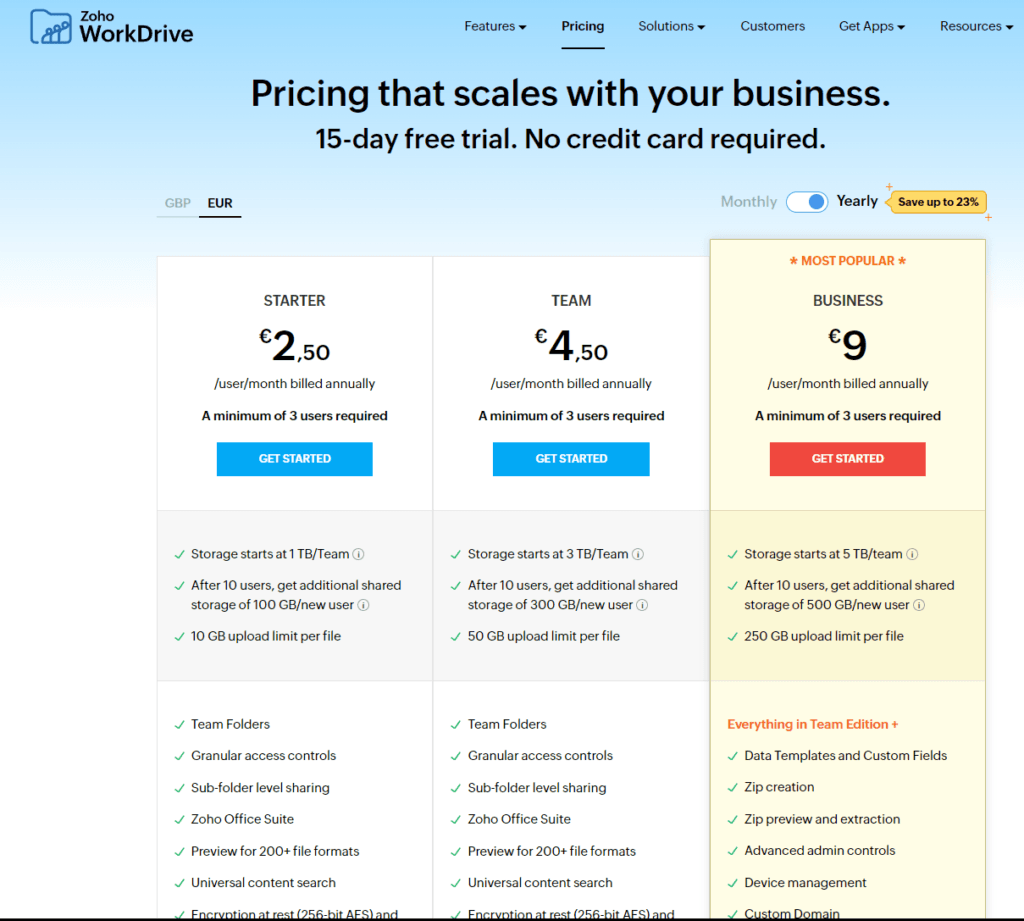In the digital age, the quest for the perfect document management tool can feel like trying to find the most comfortable pair of shoes in an endless online store. You need something that not only fits just right but also supports you every step of the way. In the vast marketplace of document management solutions, two names often come up: SharePoint and Zoho Docs. Each platform offers its own unique set of features, but which one will carry your organization towards efficiency and productivity without giving you blisters? Let’s dive into this comparison, starting with one of the most foundational aspects: Integration Capabilities.
SharePoint | Zoho Docs |
|---|---|
| G2 Score – 4 out of 5 stars | G2 Score – 4.3 out of 5 stars |
| TrustRadius Score – 7.9/10 | TrustRadius Score – N/A |
Integration Capabilities: The Key to a Seamless Digital Workflow
In our interconnected digital work environments, a document management system’s ability to integrate smoothly with existing applications is not just a convenience—it’s a necessity. Here’s how SharePoint and Zoho Docs stand up to the challenge.
SharePoint: The Powerhouse of Integration
Owned by Microsoft, SharePoint is not just a document management system; it’s a robust platform designed to integrate deeply with the Microsoft ecosystem and beyond. SharePoint excels in its ability to seamlessly mesh with other Microsoft products like Office 365, Teams, and OneDrive, creating a unified environment where documents flow freely between applications. This integration extends to Microsoft’s broader suite of tools, including Power BI for analytics and Power Automate for workflow automation, offering businesses a comprehensive solution that supports complex digital workflows.
Beyond Microsoft’s own products, SharePoint also offers connections to numerous third-party applications through connectors and APIs, ensuring that businesses can tailor their SharePoint environment to fit their unique needs. This level of integration capability makes SharePoint a powerful ally for organizations deeply embedded in the Microsoft ecosystem or those requiring extensive customization and automation capabilities.
Zoho Docs: Simplicity Meets Connectivity
Zoho Docs, part of the broader Zoho ecosystem, provides a more streamlined approach to document management, but that doesn’t mean it falls short in integration capabilities. Zoho Docs integrates seamlessly with other Zoho applications, including Zoho Mail, Zoho Projects, and Zoho CRM, allowing for a cohesive experience across Zoho’s suite of business tools. For organizations already using Zoho products, this integration offers a smooth, unified workflow that enhances productivity and simplifies document management.
In addition to its native integrations, Zoho Docs supports connections to external cloud storage providers like Dropbox, Google Drive, and Box, and offers APIs for custom integrations. While its ecosystem may not be as extensive as SharePoint’s, Zoho Docs provides enough flexibility to support the needs of small to medium-sized businesses looking for an accessible and cohesive document management solution.
User Experience (UX) and Ease of Use: The Human Touch in Digital Document Management
A document management system should be powerful yet intuitive, allowing users to perform tasks without unnecessary complexity or frustration.
SharePoint: Rich in Features, Steep in Learning Curve
SharePoint offers a comprehensive set of features designed to accommodate a wide range of document management needs, from simple storage solutions to complex collaborative projects. However, its extensive functionality can sometimes result in a steep learning curve for new users. The interface, while highly customizable, often requires initial setup and ongoing management by an IT professional to ensure it remains user-friendly and aligned with organizational workflows.
For those deeply integrated into the Microsoft ecosystem, SharePoint’s integration with other Microsoft products can make for a smoother experience, as it allows for direct editing of documents within familiar applications like Word or Excel. However, navigating SharePoint’s full suite of features and customizations can be overwhelming for users not as familiar with Microsoft’s platform.
Zoho Docs: Streamlined Simplicity
Zoho Docs prioritizes simplicity and ease of use in its design, offering a straightforward and clean interface that makes it easy for new users to find their way around. The learning curve is significantly lower compared to SharePoint, with most users able to start managing and collaborating on documents with minimal training.
The integration within the Zoho ecosystem and with other popular cloud storage providers enhances the user experience by centralizing document management within familiar environments. Zoho Docs also offers real-time collaboration features, including document sharing, editing, and commenting, which are accessible and intuitive, making teamwork seamless and efficient.
Pricing and Total Cost of Ownership: Balancing Budget and Benefits
Understanding the pricing structure and total cost of ownership can help ensure that the selected document management system offers the best value for your organization’s investment.
SharePoint: Comprehensive but Potentially Costly
SharePoint is part of the Microsoft 365 suite, and its cost is typically bundled with other Microsoft products. Pricing can vary widely depending on the specific plan chosen, with options ranging from basic plans for small businesses to more comprehensive enterprise solutions. The cost is usually per user, per month, and increases with the level of functionality and storage required.
Beyond subscription fees, organizations using SharePoint may face additional costs for customization, integration, and training to fully leverage the platform’s capabilities. Larger organizations or those with complex needs might also need to invest in dedicated IT support to manage and maintain their SharePoint environment. However, for businesses already invested in the Microsoft ecosystem, SharePoint can offer significant value by enhancing productivity and collaboration across the suite of Microsoft tools.
Zoho Docs: Affordable and Transparent Pricing
Zoho Docs offers a straightforward and transparent pricing model, with a clear distinction between free, standard, and premium plans. The cost is determined by the number of users and the level of features required, making it easy for small to medium-sized businesses to understand and predict their expenses. Zoho Docs’ pricing is competitive, particularly for SMEs looking for a cost-effective document management solution.
The total cost of ownership for Zoho Docs is generally lower than SharePoint, with fewer additional costs for customization and maintenance. Its user-friendly design and seamless integration within the Zoho ecosystem reduce the need for extensive training or IT support. For organizations looking for a straightforward, no-frills document management system, Zoho Docs provides an affordable option without compromising on essential features.

Related: Check out our free SEO suite

Security Features and Compliance Standards: Safeguarding Your Digital Assets
A robust document management system must not only streamline operations but also protect against threats and ensure regulatory compliance.
SharePoint: Enterprise-Level Security and Compliance
SharePoint benefits from Microsoft’s extensive investment in security and compliance infrastructure. It offers a comprehensive suite of security features, including advanced data encryption, threat management, and information rights management. These features are designed to protect against external threats and prevent unauthorized access or sharing of sensitive information.
SharePoint excels in meeting a broad range of global and industry-specific compliance standards. Leveraging Microsoft’s global compliance portfolio, SharePoint supports GDPR, HIPAA, ISO 27001, and more, making it an ideal choice for organizations operating under strict regulatory requirements. Furthermore, SharePoint provides extensive audit capabilities, allowing organizations to track and report on data access and document handling processes, essential for maintaining compliance and managing risk.
Zoho Docs: Secure and Compliant Document Management for SMEs
Zoho Docs also prioritizes security, offering SSL encryption, two-factor authentication, and secure file sharing options to protect your data. While perhaps not as extensive as SharePoint’s security offerings, Zoho Docs’ features are well-suited to the needs of small and medium-sized enterprises (SMEs), providing a solid level of protection that balances security with ease of use.
Zoho Docs adheres to compliance standards relevant to SMEs, including GDPR. While its compliance certifications might not cover as broad a range as SharePoint’s, Zoho ensures that businesses have the necessary tools for data protection and privacy, aligning with best practices and regulatory expectations.
Collaboration and Communication Features: Fostering Teamwork in the Digital Workspace
The strength of a document management system in supporting teamwork can significantly impact productivity and project success.
SharePoint: Enhancing Collaboration with Comprehensive Tools
SharePoint, as part of the Microsoft ecosystem, is inherently designed for collaboration. It offers deep integration with Microsoft Teams, allowing users to collaborate on documents in real-time, hold meetings, and communicate via chat within the context of their documents. SharePoint’s version control and co-authoring capabilities ensure that team members can work on documents simultaneously without overwriting each other’s changes, promoting a seamless collaborative experience.
Beyond document collaboration, SharePoint serves as a comprehensive intranet solution where organizations can publish news, updates, and resources, further enhancing internal communication. Its customizable team sites can be tailored to specific project needs, providing a centralized space for team resources, timelines, and discussions.
Zoho Docs: Streamlining Collaboration for Small and Medium Businesses
Zoho Docs provides a straightforward set of collaboration tools tailored to the needs of SMEs. Real-time editing, commenting, and sharing features allow team members to collaborate on documents efficiently, with changes tracked and synchronized across devices. Zoho Docs also integrates with Zoho Projects, facilitating project-based collaboration and document management within project workflows.
While Zoho Docs may not offer an integrated communication platform akin to Microsoft Teams, it supports effective team collaboration through document comments and task assignments. For broader communication needs, businesses can leverage other tools within the Zoho suite, such as Zoho Cliq, for messaging and Zoho Connect for building an intranet, although these require navigating multiple platforms.
Storage and File Management Capabilities: Organizing Your Digital Universe
The architecture and features supporting document storage and file management are foundational to the performance of a document management system. Here’s how SharePoint and Zoho Docs compare in this vital area.
SharePoint: Robust and Scalable Storage Solutions
SharePoint provides extensive storage capacities, suitable for enterprises with large volumes of data. Its deep integration with the broader Microsoft ecosystem, including OneDrive, allows for seamless file storage, sharing, and collaboration across the organization. SharePoint’s structure supports a hierarchical organization of sites, libraries, and folders, enabling detailed categorization and management of documents.
Beyond mere storage, SharePoint offers advanced document management features, including metadata tagging, customizable views, and powerful search capabilities, making it easier to locate and manage files. Version control and audit trails ensure that changes are tracked and documented, essential for managing revisions and maintaining compliance.
Zoho Docs: User-Friendly Storage and Management
Zoho Docs offers a clear and straightforward approach to document storage, aimed at meeting the needs of small to medium-sized businesses. With scalable storage options and integration with Zoho’s suite of productivity tools, it provides a cohesive environment for storing and working with documents. Cloud-based storage ensures that files are accessible from anywhere, promoting flexibility and mobility.
Zoho Docs simplifies file management with an intuitive interface, facilitating easy uploading, sharing, and organization of documents. Features such as tags, folders, and in-built search capabilities allow users to efficiently categorize and locate documents. Version history is maintained for each file, providing a straightforward way to view and revert to previous versions.
Pricing
SharePoint:

Zoho Docs:

Conclusion
In wrapping up our comprehensive comparison between SharePoint and Zoho Docs, it’s evident that both platforms offer distinct advantages tailored to different organizational needs and preferences.
SharePoint emerges as a powerful solution for larger organizations or those with complex document management needs. Its extensive integration with the Microsoft ecosystem, robust storage and file management capabilities, enterprise-level security features, and comprehensive tools for collaboration make it a formidable choice for businesses seeking a scalable and versatile document management platform. SharePoint is particularly well-suited for organizations that already rely heavily on Microsoft products and can leverage this integration to enhance productivity and collaboration.
Zoho Docs, on the other hand, offers a streamlined and user-friendly alternative, ideal for small to medium-sized businesses seeking simplicity and efficiency. With its intuitive interface, straightforward storage and file management features, and solid security and compliance standards, Zoho Docs provides SMEs with a cost-effective solution that facilitates easy document creation, sharing, and collaboration. Its integration within the Zoho ecosystem and with other popular cloud storage services ensures a seamless workflow for businesses looking for an accessible document management tool without the complexity of more comprehensive platforms.
Read Next:
- GetResponse vs Zoho Campaigns: The Best Email Marketing Tool for 2024
- AWeber vs ActiveCampaign: The Best Email Marketing Tool
- Constant Contact vs Campaigner: Best Email Marketing Tool
- GetResponse vs Omnisend: The Best Email Marketing Tool for 2024
- AWeber vs Benchmark Email: The Best Email Marketing Tool






















Comments are closed.